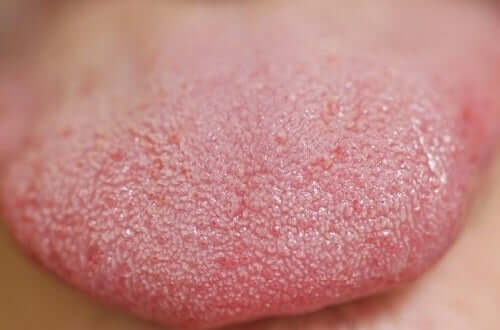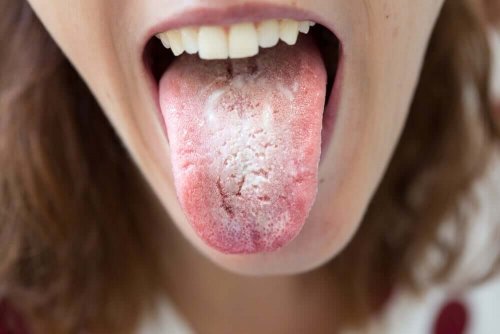What Are Black Spots on the Tongue?

It might seem strange, but black spots on the tongue are somewhat more frequent than you think. Understandably, they often worry those who have them. However, their causes are many and varied.
For one, their location and appearance vary. Also, these spots may appear on the back and even look hairy. They can also sprout in other areas, in groups or individually. They’re temporary most of the time so their duration depends on why they’re there, to begin with.
In today’s article, we’ll explain what the main causes of black spots on the tongue are together with their possible consequences.
What causes black spots on the tongue?
Under normal conditions, the tongue is red and covered with small bumps called papillae. However, there are some instances in which the papillae lose color swell, thus having the appearance of black spots.

Black spots on the tongue are usually due to poor oral hygiene. However, they can also be a symptom of oral cancer, problems with medication, and smoking.
Black hairy tongue
In this case, the tongue becomes dark and has a hairy appearance. It happens because dead skin cells aren’t exfoliating as they should. Thus, they accumulate and lead to swelling of the papillae. This is because the papillae are responsible for trapping bacteria, food debris, tobacco traces, and so on. These substances dirty the tongue.
This is a mild and temporary oral condition. Many processes could cause it:
- The use of antibiotics and irritating mouthwashes.
- Poor oral hygiene.
- Drinking coffee or black tea in excess.
- Alcohol consumption and smoking.
Having black spots on the tongue is usually alarming. However, there’s no reason for it to be so as it doesn’t necessarily lead to further health problems and is painless. Thus, it usually goes by eliminating the above factors and following proper oral hygiene.
You may be interested: Seven Natural Remedies for a White Tongue
Hyperpigmentation of the tongue
This is a benign disorder that also leads to black spots on the tongue. It’s relatively common in African and Asian ethnicities. It commonly happens between the ages of 20 and 30, although it does manifest in some children. Generally, it affects the tongue’s lateral surfaces and its tip.
The cause for this condition is still unknown, although scientists are investigating the possibility of a genetic factor. Some studies continue to try to demonstrate the type of inheritance of this pathology.
Fungal infection
Fungal infection is common in people with poor oral hygiene. However, the black spots might also appear after taking certain antibiotics. This is because antibiotics alter the bacteria of the tongue, including the good kind.

Injuries and wounds
Even though we seldom stop to think about it, the tongue can also bruise. Any blow or bite that doesn’t tear the tissue could form a small bruise on the tongue. It often looks like small black spots on the tongue.
You might like: Six Home Remedies for Tongue Ulcers
Black spots on the tongue due to medication
As we mentioned before, antibiotics can weaken the tongue’s microbiota. So, it’s easier to catch a fungal infection.
However, some medications can also cause black spots on the tongue. The mechanism of this side effect is complex. However, it’s just a transitory situation. Your tongue will be normal again as soon as you stop taking it.
The important thing about black spots on the tongue
Black spots on the tongue may appear for different reasons. However, most cases are due to bad habits such as improper oral hygiene and smoking. Thus, it’s very important to maintain proper hygiene. Also, most dentists recommend brushing your teeth at least twice a day. Similarly, you must floss and gargle daily.
Also, try to quit toxic habits such as smoking. Tobacco doesn’t only cause black spots on the tongue, it could also lead to oral cancer.
Consult your doctor if you notice changes in the color of your tongue or any part of your mouth. They’ll do any necessary relevant tests to diagnose you and to rule out any carcinogenic processes.
All cited sources were thoroughly reviewed by our team to ensure their quality, reliability, currency, and validity. The bibliography of this article was considered reliable and of academic or scientific accuracy.
- Domínguez P, Minguella I. Tractament de la cetoacidosis diabètica. But Soc Cat Pediatr 1989; 49: 385-95.
- Fernández Y, Palomeque A, Luaces C, Pons M, Gibert A, Martín JM. Tratamiento de la cetoacidosis diabética. Arch Pediatr 1995; 46: 443-6.
- Rodríguez Hierro F. Diabetes mellitus (I). En: Argente J, Carrascosa A, Gracia R, Rodríguez Hierro F, editores.
Tratado de Endocrinología Pediátrica y de la adolescencia. Madrid: Edimsa; 1995. p. 943-64. - Rodríguez F, Torres M. Diabetes: pauta de actuación en el Servicio de Urgencias ante un posible debut diabético. En: Pou-Fernández J, editor. Urgencias en Pediatría. Protocolos diagnóstico-terapéuticos. Madrid: Ergon; 1999. p. 349-58.
- Corripio Collado R, Rivera Luján J, Gallach Figueras I. Urgencias endocrino-metabólicas: Diabetes Mellitus. En: Benito J.
This text is provided for informational purposes only and does not replace consultation with a professional. If in doubt, consult your specialist.









